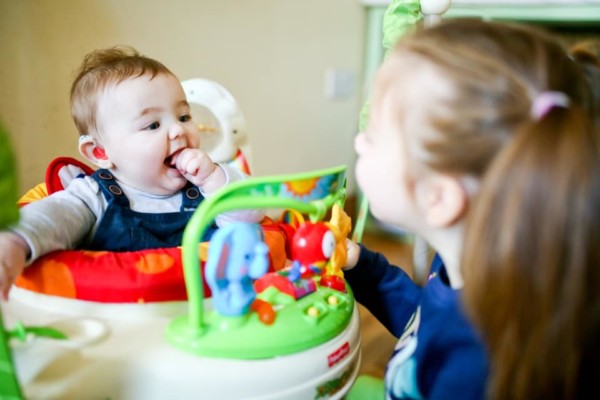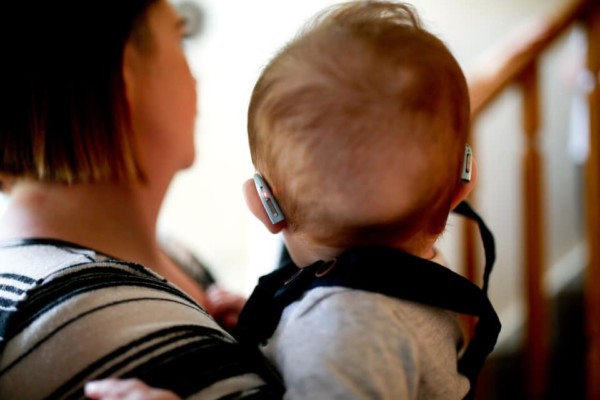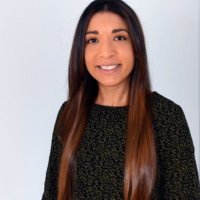Working for better outcomes in speech and language for babies with hearing loss – World Hearing Day 2021
Although there have been significant strides in the support for babies with hearing loss during the last 20 years, a recent study led by NIHR Manchester Biomedical Research Centre researchers has shown that babies are not wearing their hearing aids as often as they need to for optimal benefits. On World Hearing Day Manchester BRC researcher Ciara Kelly explains why her research is focussed on addressing this.
Babies learn about language even before they are born
It is an exciting time when babies reach that all important milestone of saying their first words. Before we know it, they have added more words to their vocabulary, including that inevitable word ‘No!’ But their language learning journey begins long before they utter their first words. From as early as the third trimester of pregnancy, when the auditory system is fully working, babies are learning about the sounds, rhythm, and intonation of their native language and can even distinguish between theirs and a foreign language hours after they are born. Their auditory system continues to develop and they continue to show a remarkable ability to navigate life’s sea of sounds as they figure out and tune in to what’s important for language learning, learn about the regular sound patterns of their language, extract words from streams of speech, and ultimately map sound to meaning – they learn words and how to use them.
The implications for babies born with hearing loss learning a spoken language
Approximately one in 1000 babies are born with permanent hearing loss; making it one of the most prevalent chronic conditions in children. Hearing loss can make a baby’s language learning journey harder because access to their auditory environment is affected to some degree, meaning they are at significant risk of delays in language development. However, thanks to technological advancements and more research within the field, the last 20 years have seen great improvements in the speech and language outcomes of children with hearing loss.

One major advancement has been the development of technologies to identify hearing loss within the first few days of birth. This was a huge turning point for the development of children with hearing loss because it meant that many countries were able to introduce newborn hearing-screening programmes in the early 2000s – including England in 2006, the first country in the world to offer a newborn hearing check to every baby – which brought the age of identification down from around two years of age to soon after birth. Now, steps can be taken to support language development from very early on, significantly improving chances for better language outcomes; and one important early step is regular hearing aid use.
Using hearing aids in the first weeks of birth is really important
Hearing aids help babies access speech sounds, which are critical for spoken language development and to develop the auditory parts of the brain, especially in the first year of life. Consistent use of well-fit and functioning hearing aids from an early age is associated with better development and outcomes.
Yet, research – including a recent study led by Dr Anisa Visram here in our Hearing Health Theme within Manchester BRC – has shown that babies are not wearing their hearing aids as often as they need to for optimal benefits, and that achieving consistent hearing aid use can be a challenge for parents. Some of these challenges include struggling to get into a routine, hearing aids not working properly, and babies pulling them out – which raises safety concerns as they become a choking hazard. There is now increasing recognition of the need to support families to establish consistent hearing aid use for babies with hearing loss, and is something both parents and audiologists have expressed a need for.

Working towards optimal hearing aid use for babies
As a result of the research by Anisa and colleagues, we have been awarded funding from the National Deaf Children’s Society to work towards meeting this need. As a first step, we are now in the process of developing a better understanding of the barriers families face in establishing regular hearing aid use by looking at all the existing research into possible barriers, and by speaking with parents who have a baby with hearing loss and professionals such as paediatric audiologists and Teachers of the Deaf. With this understanding, we plan to develop a programme of support to equip parents with information and strategies to overcome the barriers they face in establishing consistent hearing aid use. We hope that this work will lead to a useful tool for professionals and clinicians working with families who have a baby with hearing loss.
The last 20 years have seen significant strides in the support for babies with hearing loss with really positive outcomes, and it’s exciting to be part of a project that is contributing to the work that is pushing forward towards the goal of closing the developmental gap for babies with hearing loss.
